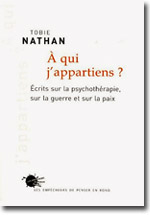![]()
Diasporas and Identity in a new world
presentation of the book To Whom do I Belong (À qui j'appartiens)[1]
par Tobie
Nathan

Tobie Nathan
From this point of view, we could describe — which is what some of you did — multiple, unstable and changing identities throughout life, attributing equal value to each. If the first way of defining identity at the intersection of institutional categories, in the manner of a descriptive sheet, is relevant to the police or to customs officials, the second way, pertaining to the multiplicity of belonging, is similar to the journalist’s point of view, the chronicler of passing time… Everyone knows, however, that the world doesn’t work that way… Identity, in the common sense, is not like a passport photo; it holds considerable power… We all know that at once asserted, enthusiastic and frenzied identity shakes the world, taking hold of people’s minds. Such identity, which almost reflects the word’s literal meaning: the fact of being what one is and nothing else (than what one is) is indeed at the root of claims, of political action and territorial disputes.
But the question remains: who can say he or she is what he or she is and nothing else?… When I question my Yoruba friend from Benin, whose family is from Porto Novo, when I ask him “Are you Yoruba?”, his answer is: “I’m a crocodile”… And if I ask myself the same question, I have to admit that, in this very restrictive sense, to the Jews, only God has an identity, He alone is what He is and nothing else, He who precisely introduces Himself to Moses (Moshé) in the following way : “I AM WHO I AM[2] (eyeh asher eyeh).

Tobie Nathan : À qui j'appartiens? Écrits sur la psychothérapie, sur la guerre et sur la paix. Paris, Le Seuil — les empêcheurs de penser en rond, 2007.
Thus, we find ourselves faced with an aporia: in order to explain and describe transnational diasporas, you need the concept of identity — a psychological concept — however this very notion, this “identity”, slips from your grasp as soon as you try to define it. Now, the modern world has further confused the issue — and many speakers here addressed this new situation. It is as though the world was saying: it is impossible to consider identity, meaning permanence, simply as a kind of essential nature, as in “I am a crocodile”; it must be considered first and foremost as a plan or a project, in other words the projection of one’s being into a becoming. “I am taking on this project — a life plan or a political project — that defines a destiny for me from which I can infer a past”. As one looks at the world in flux, such are the modalities that compel recognition.
It is no longer possible to simply “assimilate” or “integrate”… new arrivers considered severed from their group of origin. Indeed today’s immigrants stay in touch with their nucleus, thanks to the telephone which is now almost free, thanks to the web; they exchange, videotapes, photographs, instant messages and webcam conversations with their relatives; they watch their national television channels thanks to satellite TV (I met several who managed not to learn a word of French after 20 years living in France). Obviously, such opportunities to maintain and preserve family and cultural ties spectacularly reinforce the awareness of belonging to a same people, despite physical distance. It is as though the world were establishing this vision of identity as a project.
Needless to say, such closeness now makes it possible to generalize to the entire world that which up until recently had been the exclusive specialty of certain peoples, diaspora experts, such as the Jews, the Chinese, the Yoruba of Benin and Nigeria or the Armenians. Let me remind you of the extraordinary story of the Man clan, studied by James Woody Watson, whose members claim to be descendants of one single ancestor who lived near Canton six centuries ago. Thousands of them have spread out across the planet, in England, Canada, the Netherlands, Belgium or Germany. Many no longer speak Chinese and have married spouses from the host country. Yet they are nonetheless carrying out a clan-type family “plan” or “project” (in the sense I mentioned earlier). Within this group, certain marriages are organized according to tradition and economic relations are constantly maintained beyond national borders. Some have returned to the original villages in China, where they are restoring cemeteries and building new temples to their ancestors in order to organize traditional rituals[3] . Another similar example are the well-documented gatherings around Yoruba and Ibo kings in Nigeria bringing together immigrants, sometimes millionaires, from Western countries of immigration.
Present-day sociologists and political scientists,
aware of these phenomena, now speak of the existence of “transnations”
or of “long distance nationalism”. And we are in effect
witnessing political lobbying of international institutions in favor
of group identities which are independent from given states.
Inspired by such terminology, I have described what I termed “long
distance attachments” that dynamically reveal their existence
through complex psychological processes observable only in the very
specialized context of pathology and therapy. Such specific expertise
has allowed me to describe in detail the mechanisms around which those
identities resistant to distance in time and space are organized. Indeed,
it is often illness — especially mental illness — that reminds
the individual of his or her attachment to his or her nucleus. Because,
when a man from West Africa, for example, presents with symptoms of
mental illness in Paris, it often happens that at the end of his treatment,
he comes to the realization that he has been captured by the village
ancestor who is forcing him, through his illness, to return to his home
village in order to perform certain rituals. Thus, the internal compulsion
that guarantees identity often results from the action of invisible,
non-human, beings: such as spirits, ancestors, or gods… Hence,
at the close of this discussion on diasporas, I have come to think that
the interesting question isn’t “who am I?” but rather
“to whom do I belong”, “to whom”, meaning “to
which invisible non human being?”

[1]. À qui j'appartiens? Écrits sur la psychothérapie, sur la guerre et sur la paix. Paris, Le Seuil — les empêcheurs de penser en rond, 2007.
[2].Exodus 3:14. eyeh asher eyeh. “I AM WHO I AM. Say this to the children of Israel, ‘I AM has sent me to you’”
[3].See an article by Stanley Tambiah, « Transnational Movements, Diaspora and Multiple Modernities. International Movements of People and their implications » ; Daedalus, hiver 2000, 163-194 (cited by Bordes-Benayoun & Schnapper 2006). In the same line of thought, Ernest Sin Chan (2005), in his important study of the Hakka Chinese in Polynesia, reports similar facts, emphasizing the importance of pathologies and therapies in the preservation of the original identity.

translation in English by Catherine Grandsard
Droits de diffusion et de reproduction réservés © 2007, Centre Georges Devereux